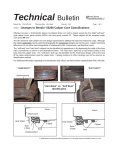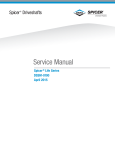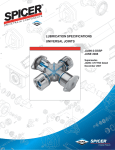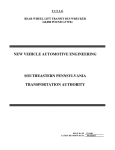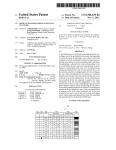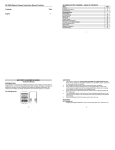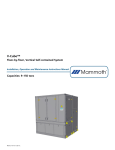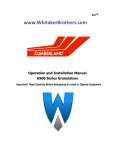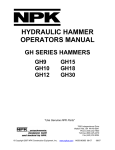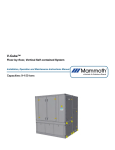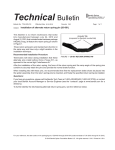Download service manual: 1000
Transcript
Spicer Driveshafts ® Service Manual DSSM3264 September 2007 Table of Contents Safety . . . . . . . . . . . . . . . . . . . . . . 1 Lubrication . . . . . . . . . . . . . . . . . . .11 General Safety . . . . . . . . . . . . . . . . . . . . . . . . . . 1 Component Safety . . . . . . . . . . . . . . . . . . . . . . 2 Driveline . . . . . . . . . . . . . . . . . . . . . . . . . . . 2 End Fitting . . . . . . . . . . . . . . . . . . . . . . . . . . 2 Universal Joint . . . . . . . . . . . . . . . . . . . . . . 2 Slip Member . . . . . . . . . . . . . . . . . . . . . . . . 2 Yoke (Includes Slip Yoke, Yoke Shaft, and Tube Yoke) . . . . . . . . . . . . . . . . . . . . . . 2 Tubing . . . . . . . . . . . . . . . . . . . . . . . . . . . . . 3 Midship Nut . . . . . . . . . . . . . . . . . . . . . . . . 3 Center Bearing . . . . . . . . . . . . . . . . . . . . . . 3 Foreign Material . . . . . . . . . . . . . . . . . . . . . 3 Hardware . . . . . . . . . . . . . . . . . . . . . . . . . . 3 Lubrication (When Applicable) . . . . . . . . . . 4 Spicer 10 Series™ Universal Joint and Slip Members Lubrication Intervals . . . . . .11 Lubrication for Universal Joints . . . . . . . . . . . .12 Grease Compatibility . . . . . . . . . . . . . . . . .12 Lubrication Procedure for Universal Joints 12 Quick Disconnect™ (Half Round) Universal Joints . . . . . . . . . . . . . . . . . . . . .13 Bearing Plate (Full Round) Universal Joints . . . . . . . . . . . . . . . . . . . . . . . . . . . . .14 Snap Ring Universal Joints . . . . . . . . . . . .14 Lubrication for Slip Members . . . . . . . . . . . . .15 Lubrication of Center Bearing Assemblies . . . .15 Inspection . . . . . . . . . . . . . . . . . . . 5 End Fitting Inspection . . . . . . . . . . . . . . . . . . . . 5 Bearing Plate (Full Round) Yoke Inspection . . . . . . . . . . . . . . . . . . . . . . . . . . 6 Quick Disconnect™ (Half Round) End Yoke Inspection . . . . . . . . . . . . . . . . . . . . . 7 Universal Joint Inspection . . . . . . . . . . . . . . . . . 8 Re-lubable Style Universal Joints . . . . . . . . 8 Permanently Greased Plug Style Universal Joints . . . . . . . . . . . . . . . . . . . . . 8 Slip Member Assembly . . . . . . . . . . . . . . . . . . . 9 Tubing . . . . . . . . . . . . . . . . . . . . . . . . . . . . . . . . 9 Center Bearings . . . . . . . . . . . . . . . . . . . . . . . 10 Midship End Fitting . . . . . . . . . . . . . . . . . . 10 Disassembly and Reassembly . . . . .16 Universal Joint . . . . . . . . . . . . . . . . . . . . . . . . .16 Disassembly - Snap Ring Design . . . . . . . .16 Reassembly - Snap Ring Design . . . . . . . .17 Disassembly - Bearing Plate Style . . . . . . .18 Reassembly - Bearing Plate Style . . . . . . .18 Center Bearing Assembly . . . . . . . . . . . . . . . . .20 Disassembly - Inboard Slip Style . . . . . . . .20 Midship Nut Specifications Table . . . . . . . .22 Disassembly - Outboard Slip Style . . . . . . .23 Reassembly - Inboard Slip Style . . . . . . . .24 Recommended Center Bearing Lubricants . . . . . . . . . . . . . . . . . . . . . . . . .24 Midship Nut Installation Procedure . . . . . .24 Reassembly - Outboard Slip Style . . . . . . .25 Recommended Center Bearing Lubricants . . . . . . . . . . . . . . . . . . . . . . . . .25 Grease Zerk (Nipple) Fittings or Plugs . . . . . . .26 Universal Joints and Slip Member Assembly . . . . . . . . . . . . . . . . . . . . . . . . . .26 Universal Joint Grease Zerk (Nipple) Fitting and Plug Torque . . . . . . . . . . . . . . .26 Glossary . . . . . . . . . . . . . . . . . . . .27 Safety Safety General Safety The following WARNINGS and CAUTIONS should be read and understood before attempting any service or repair on the various components of the driveshaft assembly. CAUTION Spicer 10 Series™ Driveshaft assemblies can weigh in excess of 100 pounds (46 kilograms). Be sure to use proper lifting techniques when handling Spicer 10 Series™ Driveshaft assemblies. More than one person may be needed when handling driveshaft assemblies. 8. CAUTION Under no circumstances should individuals attempt to perform driveline service and/or maintenance procedures for which they have not been trained or do not have the proper tools or equipment. WARNING Failure to take common sense, precautionary measures when working on a vehicle or other machinery could result in property damage, serious personal injury, or death. To avoid property damage, serious personal injury, or death, please follow basic safety rules as noted below. 1. ALWAYS wear safety glasses when performing maintenance or service. Failure to do so can result in personal injury and/or partial or complete vision loss. 2. NEVER perform service or maintenance tasks underneath a vehicle while the engine is running. Be sure the vehicle engine is off and the keys are removed from the ignition. 3. NEVER perform service or maintenance tasks underneath a vehicle that is not on a level or flat surface. 4. NEVER work on a driveshaft without blocking the vehicle wheels and releasing all parking brakes. 5. ALWAYS wear gloves when handling parts with sharp edges or abrasive surfaces. 6. NEVER lift a vehicle without the appropriate weightrated vehicle-lift equipment. Always properly support the vehicle with appropriate weighted support equipment. 7. NEVER remove a driveshaft from a vehicle without keeping the transmission in neutral. ALWAYS use support straps to prevent the driveshaft from falling out of the vehicle during the removal and installation process. Note: This manual does not discuss the removal and installation of Spicer 10 Series™ Driveshaft assemblies from the vehicle. It only covers the disassembly and reassembly of component parts of the driveshaft assembly. Please refer to the original-equipment manufacturer’s service documentation for removal and installation procedures. 9. NEVER heat components, and never use sledgehammers or floor jacks to remove the driveshaft from the vehicle. Note: For driveshaft applications that have pillow blocks, dampers, parking brakes, or retarders, refer to these component manufacturers’ or the original equipment manufacturer’s service manuals for the proper procedures. NEVER perform any unauthorized procedures that will change the disconnected properties of Spicer products. WARNING ROTATING DRIVESHAFTS • Rotating auxiliary driveshafts are dangerous. You can snag clothes, skin, hair, hands, etc. This can cause serious injury or death. • Do not go under the vehicle when the engine is running. • Do not work on or near an exposed shaft when engine is running. • Shut off engine before working on power take-off or driven equipment. • Exposed rotating driveshafts must be guarded. 1 Safety Note: Spicer 10 Series™ Driveshafts are found on vehicles throughout the world. Therefore, this manual includes worldwide terminology. Safety Component Safety Driveline WARNING Failure to replace damaged driveline components can cause driveline failure, which can result in separation of the driveline from the vehicle. A separated driveline can result in property damage, serious personal injury, or death. Reassembly of a driveline out of original phase can cause vibration and failure of the driveline and attaching components. Driveline failure can result in separation of the driveline from the vehicle, resulting in property damage, serious personal injury, or death. Driveshaft assemblies can weigh in excess of 100 pounds (46 kilograms). Be sure to use proper lifting techniques when handling driveshafts. More than one person may be needed when handling driveshaft assemblies. CAUTION Never heat components, never use sledge hammers, and never use floor jacks to disassemble driveshafts. This can result in damaged, weakened, or bent components. End Fitting WARNING A loose end-fitting can result in driveline failure, which can in turn lead to separation of the driveline from the vehicle. A separated driveline can lead to property damage, serious personal injury, or death. Universal Joint WARNING Excessive looseness across the end of universal joint bearing cup assemblies can cause imbalance or vibration in the driveshaft assembly. Imbalance or vibration can cause component wear, which can result in separation of the driveline. A separated driveline can lead to property damage, serious personal injury, or death. DO NOT reuse bolts or use inferior grade bolts. Reuse of bolts and/or use of inferior grade bolts can cause driveline failure, which can result in separation of the driveline from the vehicle. A separated driveline can result in property damage, serious personal injury, or death. 2 Failure to torque bolts to specification can cause driveline failure, which can result in separation of the driveline from the vehicle. A separated driveline can result in property damage, serious personal injury, or death. CAUTION Use a journal locator to avoid nicking journal cross trunnions or damaging oil seal slingers. If a bearing assembly or journal cross is worn or damaged, the universal joint assembly must be replaced. Be sure the snap rings are properly seated in the snap ring grooves. Slip Member WARNING Excessive radial looseness in the slip member assembly can cause imbalance or vibration in the driveshaft. Imbalance or vibration can cause components to wear, which in turn can result in separation of the driveline from the vehicle. A separated driveline can cause property damage, serious personal injury or death. Yoke (Includes Slip Yoke, Yoke Shaft, and Tube Yoke) WARNING A loose or damaged slip yoke seal allows contaminants to invade the slip member assembly. Invasion of contaminants into the slip member assembly can degrade the grease, and damage slip member components, which can result in driveline separation. A separated driveline can result in property damage, serious personal injury, or death. DO NOT deform yoke cross holes by removing excessive metal. Raised metal or deformed yoke cross holes can be a cause of cross and bearing failure, which can result in separation of the driveline from the vehicle. A separated driveline can result in property damage, serious personal injury, or death. Yoke shaft assemblies can weigh in excess of 50 pounds (23 kilograms). Be sure to use proper lifting techniques when handling yoke shafts. Safety Tubing Center Bearing WARNING CAUTION Do not bend or dent the tube when handling or servicing driveshaft. Midship Nut Loose center bearing bracket bolts can result in driveline failure, which can result in separation of the driveline from the vehicle. A separated driveline can result in property damage, serious personal injury, or death. Damaged center bearings or center bearing components can cause imbalance or vibration in the driveshaft assembly. Imbalance or vibration can cause component wear, which can result in separation of the driveline from the vehicle. A separated driveline can result in property damage, serious personal injury, or death. Foreign Material WARNING WARNING DO NOT reuse the midship nut. Reuse of the midship nut can cause driveline failure, which can result in separation of the driveline from the vehicle. A separated driveline can result in property damage, serious personal injury, or death. DO NOT touch or disturb the micro-encapsulated adhesive found on the midship nut threads. Doing so may initiate the curing process and impair the installation of the nut. Premature curing of the micro-encapsulated adhesive will result in the improper installation of the midship nut. Improper installation of this nut can cause driveline failure, which can result in a separation of the driveline from the vehicle. A separated driveline can result in property damage, serious personal injury, or death. Failure to torque the midship nut to required specifications can cause driveline failure, which can result in separation of the driveline from the vehicle. A separated driveline can result in property damage, serious personal injury, or death. A loose midship nut can result in driveline failure, which can result in separation of the driveline from the vehicle. A separated driveline can result in property damage, serious personal injury, or death. Build-up of foreign material, excessive paint, or undercoating on a driveshaft can cause imbalance or vibration in the driveshaft assembly. Imbalance or vibration can cause component wear, which can result in separation of the driveline from the vehicle. A separated driveline can result in property damage, serious personal injury, or death. A contaminated slip member can result in separation of the driveline from the vehicle. A separated driveline can result in property damage, serious personal injury, or death. Hardware WARNING Loose, missing, or damaged bearing retainers or stamped straps, retaining bolts, nuts, end fitting tangs, snap rings, or rotating bearing cups can result in driveline failure. A separated driveline can lead to property damage, serious personal injury, or death. DO NOT reuse bolts, straps, nuts, or damaged bearing retainers, or use inferior grade bolts. Reuse of bolts, straps, nuts, or damaged bearing retainers, or use of inferior grade bolts, can cause driveline failure, which can result in separation of the driveline from the vehicle. A separated driveline can result in property damage, serious personal injury, or death. CAUTION If loosening or removing bolts, always install a new strap and bolts and torque bolts to specification. 3 Safety Bent or dented tubing can cause imbalance or vibration in the driveshaft assembly. Imbalance or vibration can cause component wear, which can result in separation of the driveline from the vehicle. A separated driveline can result in property damage, serious personal injury, or death. WARNING Safety Lubrication (When Applicable) WARNING A missing, loose, or fractured grease zerk (nipple) fitting or plug eliminates the ability to lubricate the universal joint. Improper or inadequate lubrication can cause driveline failure, which can result in separation of the driveline from the vehicle. A separated driveline can result in property damage, serious personal injury, or death. Improper lubrication techniques can cause driveline failure, which can result in separation of the driveline from the vehicle. A separated driveline can result in property damage, serious personal injury, or death. A missing, loose, damaged, or fractured plug or grease zerk (nipple) fitting can allow contaminants to invade the universal joint. Invasion of contaminants into the universal joint can degrade grease and cause universal joint damage, which can result in separation of the driveline from the vehicle. A separated driveline can result in property damage, serious personal injury, or death. 4 Incompatible greases that are applied to universal joints and/ or slip members can result in driveline failure and can result in separation of the driveline from the vehicle. A separated driveline can result in property damage, serious personal injury, or death. Hand tightening of grease zerk (nipple) fittings or plugs is NOT recommended. Failure to torque grease zerk (nipple) fittings to specifications can result in separation of the driveline from the vehicle. A separated driveline can cause property damage, serious personal injury, or death. CAUTION In cold temperatures, be sure to drive the vehicle immediately after lubrication. This activates the slip spline and removes excess grease. Failure to do so could cause excess grease to stiffen in the cold weather and force the plug out. The end of the spline would then be open to collect contaminants and cause the spline to wear and/or seize. All slip yoke and universal joint seals should be completely purged. Inspection Inspection Spicer 10 Series™ Driveshafts should be carefully inspected at recommended original-equipment manufacturer’s service intervals and/or at Spicer recommended lubrication intervals as shown in the Lubrication section on page 11. 3. Grasp the end fitting with both hands and rotate left to right, feeling for play and backlash. There should not be any movement in the end fittings relative to the output or input shafts to which they are connected. If looseness is evident, consult transmission, axle, or transfer case original-equipment manufacturer’s service and maintenance manuals for proper end fitting to shaft specifications. 4. Visually inspect for: End Fitting Inspection This information refers to axle, transmission, transfer case, and center bearing end fittings. Please refer to the End Fitting information in Component Safety on page 2. Visually inspect all end-fitting retaining nuts or bolts for any gaps or looseness between mating surfaces. If gaps are present, consult transmission, axle, or transfer case original-equipment manufacturer’s service and maintenance manual for proper fastener specifications. If looseness is evident between the nut, yoke, or center bearing, take the driveshaft to a qualified driveshaft facility for further inspection and repair. 2. Check all end fittings for looseness. Grasp the end fitting with both hands and try to move it vertically and horizontally to feel any looseness. Inspection 1. • damaged half round bearing straps • loose bearing strap bolts • loose companion flange bolts and nuts • damaged or worn tangs on end fittings • damaged or missing snap rings • rotating bearing cups If any of these conditions are present, component replacement is necessary. Refer to the original-equipment manufacturer’s recommendations for removal instructions. 5 Inspection Bearing Plate (Full Round) Yoke Inspection Please refer to the End Fitting information in the Component Safety section on page 2. 1. Refer to original-equipment manufacturer for removal of the driveshaft from the vehicle. 2. Place the driveshaft in v-blocks to remove the cross and bearing assemblies. Completely remove the cross and bearings from the yokes at both ends of the driveshaft using a universal joint removal tool. Next, disassemble the bearing assemblies from the slip yoke (and flange yoke, where applicable), using a tool kit. 4. Check the yoke lug cross holes with a No-Go Wear Gauge, and then use a Spicer Alignment Bar to inspect for damage by sliding through both cross holes simultaneously. The alignment bar will identify yoke lugs that have taken a set because of excessive torque. The raised metal or distorted lugs can be a cause of premature cross and bearing problems. 5. 3. Clean the cross holes on the yoke, and inspect the cross hole surfaces for damage or raised metal. Raised metal or fretting can be removed from yoke cross holes with a fine-toothed file and/or emery cloth. WARNING DO NOT deform yoke cross holes by removing excessive metal. Raised metal or deformed yoke cross holes can cause cross and bearing failure, which can result in separation of the driveline from the vehicle. 6 If, after proper cleaning of the cross holes, the alignment bar will not pass through both cross holes simultaneously, the yoke lugs are distorted, and the yoke or yokes should be replaced. Inspection Quick Disconnect™ (Half Round) End Yoke Inspection Please refer to the End Fitting information in the Component Safety section on page 2. 1. Remove the universal joint assembly from the end yoke, and clean the cross hole surfaces for inspection. 2. Inspect the cross hole surfaces for damaged or raised metal. Raised metal or fretting can be removed from yoke cross holes with a fine-toothed file and/or emery cloth. 4. Assemble bearing straps and bolts, tightening bolts a minimum of 30 lbs. ft. (41 N•m). Insert the alignment bar into one bushing. If the bar enters and passes through the opposite bushing, alignment is correct. If the alignment bar will not enter the opposite bushing, re-inspect for yoke seat burrs. 5. If, after proper cleaning, the alignment bar still does not pass through both bushings, the yoke lugs are distorted, and the yoke should be replaced. WARNING Inspection DO NOT deform yoke cross holes by removing excessive metal. Raised metal or deformed yoke cross holes can cause cross and bearing failure, which can result in separation of the driveline from the vehicle. Inspect the bearing caps for any indication of rotation within the cross holes. If rotation is apparent, the yoke should be replaced. 3. Check the yoke for cross hole alignment using the Spicer alignment gauge. Place the correct bushing in each lug ear, allowing a .030" (.75 mm) to .060" (1.5 mm) clearance between the tang and the bushing. 7 Inspection Universal Joint Inspection Please refer to the Universal Joint information in the Component Safety section on page 2. 1. Check for excessive looseness between the ends of the universal joint bearing cup assemblies and trunnions. 2. Grasp the inboard yoke on the driveshaft with both hands and attempt to move the yoke horizontally and vertically. There should be less than .006" (.15 mm) movement in the universal joint relative to the inboard or outboard yokes. If looseness is greater than .006" (.15 mm) in either direction, the universal joint must be replaced. See Disassembly and Reassembly on page 16. Re-lubable Style Universal Joints 1. With re-lubable style universal joints, check for the presence of all grease zerk (nipple) fittings. Grease zerk (nipple) fittings should not be missing, loose, or fractured. 2. If a grease zerk (nipple) fitting is loose, tighten it to required specifications. See the Universal Joint Grease Zerk (Nipple) Fitting and Plug Torque table on page 26. 3. If a grease zerk (nipple) fitting is fractured or missing, the entire universal joint must be replaced. Refer to Disassembly and Reassembly on page 16 for removal and replacement instructions. Permanently Greased Plug Style Universal Joints Please refer to the Universal Joint information in Component Safety on page 2. 8 1. Permanently greased plug style universal joints have a plug rather than grease zerk (nipple) fittings. Make sure the plug is not missing, loose, or fractured. If the plug is loose, tighten it to required specifications. See the Universal Joint Grease Zerk (Nipple) Fitting and Plug Torque table on page 26. 2. If a plug is missing or fractured, the entire universal joint must be replaced. Refer to recommendations in the Disassembly and Reassembly on page 16 for removal and replacement instructions. Inspection Slip Member Assembly Tubing This information refers to slip yokes and tube shaft assemblies. Please refer to the Slip Member information in the Component Safety section on page 2. Please refer to the Tubing information in the Component Safety section on page 2. 1. Check all slip yoke assemblies to be sure the slip yoke plug is not loose, missing, or damaged. If any of these situations are evident, replacement of the yoke assembly is necessary. 1. Check the driveshaft for bent or dented tubing or missing balance weights. If any of these conditions is evident, replacement of the complete driveshaft assembly or tube is necessary. 2. Make certain there is no build-up of foreign material on the driveshaft. If found, build-up should be removed carefully to avoid damaging the driveshaft. CAUTION 2. Visually inspect for the presence of the grease zerk (nipple) fitting, if applicable, on the slip yoke. Grease zerk (nipple) fittings should not be missing, loose, or fractured. 3. If a grease zerk (nipple) fitting is loose, tighten it to required specifications. See the Universal Joint Grease Zerk (Nipple) Fitting and Plug Torque table on page 26. 4. If a grease zerk (nipple) fitting is missing or damaged, the slip member assembly must be replaced. 5. Check the slip yoke seals and dust caps. Make sure the seal is properly attached to the slip yoke and is not loose or damaged. If any of these situations are evident, replacement of the slip member and/or seal may be necessary. 6. For an inboard and outboard slip yoke assembly design, check to be sure the slip yoke welch plug is not loose, missing, or damaged. 7. If there is excessive looseness between the mating components, with the presence of vibration, all slip assembly components should be replaced. 9 Inspection Do not allow solvents to come in contact with seals or greasible areas of the driveshaft assembly. If foreign material cannot be removed without complete assurance that the driveshaft will not be damaged, the complete driveshaft should be replaced with a new OEM driveshaft. Inspection Center Bearings Please refer to the Center Bearing information in the Component Safety section on page 2. 1. 2. Inspect the center bearing bracket bolts for looseness. If looseness is evident, re-tighten the center bearing bracket bolts. Consult the vehicle manufacturer’s documentation for proper bolt torque. Check the alignment of the bracket before tightening the bolt. Bracket should not be skewed more than 3° in relation to the centerline of the driveshaft. Visually inspect the center bearing rubber cushion for damage. Make sure the slingers are not rubbing against the rubber cushion. Verify that the rubber cushion is properly seated in the metal bracket. If any of these conditions are evident, replacement of the center bearing assembly is necessary. Refer to recommendations in the Disassembly and Reassembly on page 16 for proper center bearing replacement procedures. Midship End Fitting Please refer to the safety information in the General Safety section and the Midship Nut information in the Component Safety section on page 2. 1. Inspect the center bearing end fitting and bolt hole threads for damage. If the bolt hole threads are damaged, the end fitting must be replaced. 2. Check the center bearing end fitting and fitting nut washer for any looseness. Grasp the end fitting with both hands, and try to move it both vertically and horizontally to feel for looseness. There should NOT be any movement in the center bearing end fitting relative to the midship tube shaft to which it is connected. If any of these conditions are present, the center bearing end fitting and midship tube shaft must be replaced as a pair. 3. Refer to the End Fitting Inspection section on page 5 for proper procedures. Note: Repeat the same inspection steps for all center bearings within the driveline. 10 Lubrication Lubrication Lack of proper lubrication is among the most common causes of universal joint and slip member problems. Properly sized Spicer universal joints that are adequately lubricated at recommended intervals will normally meet or exceed vehicle operation requirements. Note: Spicer 10 Series™ relube style universal joints contain only enough grease to provide needle roller bearing protection during storage and shipment. It is therefore necessary to completely lubricate each replacement universal joint after assembly into the end fitting. Inadequate service intervals and failure to properly lubricate the universal joints will cause universal joint failures. Proper lubrication purges all universal joint seals, thus removing abrasive contaminants from the bearing assemblies. Slip members must also be adequately lubricated to prevent slip member failure. Members Lubrication Intervals 1. Carefully review the lubrication specifications found in this manual. 2. Be sure to lubricate at the recommended intervals. See the table below. 3. Be sure to use only recommended greases that meet the listed criteria. See “Lubrication for Universal Joints” on page 12. 4. Carefully follow driveshaft inspection procedures as outlined in this manual. Note: It is essential that all bearing seals be completely purged of old grease and contaminants. If only fresh grease can be seen at all seals, the purging process is complete, and the universal joint is properly lubricated. Spicer 10 Series™ Universal Joint and Slip The Spicer 10 Series™ Driveshafts include 1310 through 1880. Highway Line Haul On/Off Highway Off-Highway and Industrial* 5,000/8,000 Miles (8,000/12,000Km) or 3 months (whichever comes first) 10,000/15,000 Miles (16,000/24,000Km) or 3 months (whichever comes first) 10,000/15,000 Miles (16,000/24,000Km) or 30 days (whichever comes first) 500/200 Hrs. 5,000/8,000 Miles (8,000/12,000Km) or 3 months (whichever comes first) Lubrication City *Grease cycles for off-highway and industrial uses vary depending on the application and operating conditions. In general, to obtain maximum life, lubrication should occur every 500 hours for normal service and every 200 hours for continuous service or severe environmental conditions. Spicer Driveshaft recommends lubricating with a compatible grease meeting N.L.G.I. Grade 2 specifications with an operating range of +325° F to -10° F (163° C to -23° C). For more information on Spicer Driveshaft lubrication intervals, please refer to Form #3283-SDD. • City is defined as all applications requiring a minimum of 90 percent of operation time within city limits. • Highway is defined as all applications requiring less than 10 percent of operating time on gravel, dirt, or unpaved roads. • Line Haul is defined as 100 percent of operating time on smooth concrete or asphalt. • On/Off Highway is defined as all applications operating primarily on paved roads but requiring more than 10 percent of operating time on gravel, dirt, or unpaved roads. • Off-Highway and Industrial is defined as 100 percent on gravel, dirt, or unpaved roads, or stationary applications. 11 Lubrication Lubrication for Universal Joints Spicer recommends the following requirements be met for any grease used to service most vehicular and industrial applications and all auxiliary driveshaft applications: • Use a good quality E.P. (extreme pressure) grease (Timken Test Load - 50 lbs. / 23 kg. minimum), and that • Meets N.L.G.I. (National Lubricating Grease Institute) Grade 2 specifications, and has an • Operating range of +325° F to -10° F (163° C to 23° C), which is • Compatible with commonly used multi-purpose greases. For information about grease compatibility, see the Grease Compatibility section below. Consult your local grease source for greases that meet these specifications. Note: There are instances when special lubrication is required due to original-equipment manufacturer specifications or customer requests. The lubrication recommendations listed in this manual are authorized by Spicer Driveshaft engineering. Any alternate greases or lubrication procedures are the responsibility of the user. Grease Compatibility To help reduce the effects of incompatible greases, be sure to thoroughly purge all four bearing seals on each universal joint with the new grease. Purge seals until the fresh grease is visible on the outside of all four bearing seals. It is recommended that all purged grease be wiped clean to prevent discharge into the general environment. Contact your local grease supplier for grease compatibility information. 12 Lubrication Procedure for Universal Joints Please refer to the Lubrication information in the Component Safety section. Required Materials: • N.L.G.I. Grade-2, E.P. Grease • Grease gun May Need If Bearing(s) Will Not Purge: • C-Clamp • New straps • New bolts 1. Use the proper grease to purge all four seals of each universal joint. This flushes abrasive contaminants from each bearing assembly and assures all four bearings are filled. Purge the seals. Spicer seals are made to be purged. Make sure fresh grease is evident at all four universal joint bearing seals. 2. If any of the seals fail to purge, try to push the driveshaft away from the seal that will not purge, while applying grease gun pressure. There will occasionally be one or more bearing assemblies that will not purge. Lubrication Quick Disconnect™ (Half Round) Universal Joints Series Strap Kit Assemblies Recommended Bolt Torque N•m 1310 2-70-18X 13-18 lbs. ft. 17.6 - 24.4 1330 2-70-18X 13-18 lbs. ft. 17.6 - 24.4 1350 3-70-18X 30-35 lbs. ft. 40.7 - 46.5 1410 3-70-18X 30-35 lbs. ft. 40.7 - 46.5 1480 3-70-28X 45-60 lbs. ft. 61 - 81.3 1550 3-70-28X 45-60 lbs. ft. 61 - 81.3 1610 5-70-28X 45-60 lbs. ft. 61 - 81.3 1710 6.5-70-18X 115-135 lbs. ft. 162.7 - 183 1760 6.5-70-18X 115-135 lbs. ft. 162.7 - 183 1810 6.5-70-18X 115-135 lbs. ft. 162.7 - 183 The bolt torque specifications refer to Spicer bearing straps and bearing plates only. If using original-equipment bearing straps and bearing plates, refer to manufacturer’s service manual for proper bolt torque specifications. Note: Unless otherwise noted all recommended bolt torques are with dry threads. If any of the bearing assemblies fail to purge removal of the driveshaft is necessary. See the originalequipment manufacturer for proper driveshaft removal procedures. 2. Place the driveshaft in v-blocks and apply a C-clamp across the half round bearings. Apply grease gun pressure. Completely purge both bearings. 3. If outboard bearings fail to purge, slightly loosen Cclamp and reapply grease gun pressure until both half round bearings purge. 4. After all four bearings purge fresh grease, re-tighten the C-clamp to squeeze out excess grease and wipe clean. This will ease installation of universal joint kit back into yoke. Install universal joint kit in the yoke using new straps and bolts, and torque bolts to the required specifications. Reference bolt torque specifications in the above table. 5. If the bearings still will not purge, complete removal of the universal joint kit is needed to determine the cause of blockage. Refer to original-equipment manufacturer's service manual for removal procedures. 13 Lubrication 1. Lubrication Bearing Plate (Full Round) Universal Joints Series Bolt Part Number Recommended Bolt Torque N•m 1610 5-73-709 26-35 lbs. ft. 35.3 - 47.5 1710 6-73-209 38-48 lbs. ft. 51.5 - 65.1 1760 6-73-209 38-48 lbs. ft. 51.5 - 65.1 1810 6-73-209 38-48 lbs. ft. 51.5 - 65.1 1880 7-73-315 60-70 lbs. ft. 81.3 - 94.9 The bolt torque specifications refer to Spicer bearing straps and bearing plates only. If using original-equipment bearing straps and bearing plates, refer to manufacturer’s service manual for proper bolt torque specifications. Note: Unless otherwise noted all recommended bolt torques are with dry threads. 1. There will occasionally be one or more bearing assembly seals that will not purge. Release seal tension by loosening the bolts holding the bearing assembly that does not purge. It may be necessary to loosen the bearing assembly approximately 1/16" minimum. If loosening it does not cause purging, remove the bearing assembly to determine the cause of blockage. Note: It is essential that all seals be completely purged of old grease and contaminants. If fresh grease can be seen at these seals, the purging process is complete, and the universal joint is properly lubricated. Note: Spalling and/or brinelling can be caused if contaminants (water, air, etc.) are left in the universal joint and/ or the bearing seals. Purge old grease thoroughly. 2. 14 Install new bolts, and torque to specifications in the above table. Snap Ring Universal Joints 1. There will occasionally be one or more bearing assembly seals that will not purge. If any of the seals will not purge, replacement of the universal joint kit is necessary. See the Reassembly - Inboard Slip Style under “Center Bearing Assembly” on page 20 for proper replacement procedures. Lubrication Lubrication for Slip Members Please refer to the Lubrication information in the Component Safety section on page 2. The grease used for universal joints is satisfactory for slip members. Glidecote® and steel splines both use a high quality E.P. grease meeting N.L.G.I. Grade 2 specifications. Lubrication of Center Bearing Assemblies Spicer center bearings are lubricated for life. No attempt should be made to add to or change grease within the bearing itself. Grease splines at the intervals recommended in the Lubrication Intervals table page 11. 1. Apply grease gun pressure to the grease zerk (nipple) fitting until grease appears at the pressure relief hole in the plug. Note: For pillow blocks, use original-component manufacturer’s recommended greases and lubrication intervals. Lubrication 2. Now cover the pressure relief hole with your finger and continue to apply pressure until grease appears at the slip yoke seal. Note: Use caution to prevent seal damage when using high pressure lubrication systems. 15 Disassembly and Reassembly Disassembly and Reassembly For procedures used in the removal and installation of Spicer Driveshafts from the vehicle, please consult the vehicle manufacturer’s service manual. This manual concerns itself only with the disassembly and reassembly of driveshaft components. 2. Universal Joint Set the yoke in the arbor press with a piece of tube stock beneath it. Position the yoke with the universal joint grease zerk (nipple) fitting pointing up to prevent interference during disassembly. Place an appropriate push rod on the upper bearing assembly, and press it through to release the lower bearing assembly. Disassembly - Snap Ring Design Please refer to the Universal Joint information in the Component Safety section on page 2. With the driveshaft removed, the following procedure should be followed: 1. Using snap ring pliers, remove the snap rings from the yoke ears. CAUTION Do not distort yoke ears with excessive force while in the arbor press. 16 3. If the bearing assembly will not pull out by hand after pressing, grip the bearing cup and pull from the yoke. 4. Place the yoke in the arbor press with the remaining bearing cup face down. Using an appropriate push rod, press on the end of the journal cross trunnion. Continue to press down on the journal cross trunnion until the shoulder of the journal cross makes contact with the inside of the yoke ear. 5. Repeat steps three and four on the remaining bearing assemblies to remove the cross from the yoke. 6. Inspect all yoke cross hole surfaces for damage. Raised metal or fretting can be removed from yoke cross holes with a fine-toothed file and/or emery cloth. Disassembly and Reassembly 1. Using a high quality N.L.G.I., grade 2 extreme pressure (E.P.) grease, apply adequate grease to each bearing cup assembly. Fill all the cavities between the needle rollers, and also apply a liberal coating of grease in the bottom of each bearing cup and on the lip of the seal. Be careful not to get grease on the outside machined surface of the bearing cup. 2. Position the journal cross in the yoke cross holes with the grease zerk (nipple) fitting inward toward the tubing. Failure to properly position the universal joint may result in the inability to lubricate the universal joint. If using an arbor press, proceed to Step 3. If using a universal joint installation tool, follow the tool manufacturer’s instructions. 3. Move one end of the journal cross to cause a trunnion to project through the cross hole beyond the outer machined face of the yoke ear. Check the bearings for skewed or dropped needle rollers. Place the bearing cup assembly over the protruding trunnion diameter and align it to the yoke cross hole. Align the yoke in an arbor press with the bearing assembly resting on the base of the press. Cover the yoke ear with a metal plate that has .150" (6.4 mm) minimum thickness. Push the yoke onto the bearing cup assembly until it is flush with the cross hole face. 4. Place a push rod that is smaller than the diameter of the bearing cup assembly under the bearing cup assembly, and continue pressing into the yoke cross hole until a snap ring can be installed. 5. Remove the yoke from the arbor press. Install a snap ring using snap ring pliers. 17 Disassembly and Reassembly Reassembly - Snap Ring Design Please refer to the Universal Joint information in the Component Safety section on page 2. Disassembly and Reassembly 6. 7. 18 Flip the yoke 180°. Check the bearings for skewed or dropped needle rollers. Place another bearing cup assembly over trunnion diameter, and align it to the yoke cross holes. Align the yoke in arbor press with previously installed bearing cup assembly resting on the base of the press. Place a push rod that is smaller than the bearing cup assembly on top of the bearing cup assembly. Press bearing cup assembly into the yoke cross hole until a snap ring can be installed. Remove the yoke from the arbor press. Install a snap ring using snap ring pliers. 8. Ensure snap rings are seated into the snap ring grooves. 9. Flex the journal cross to make sure it moves freely by hand. Some resistance is acceptable. If it does not move freely, tap the yoke ear as shown. Disassembly - Bearing Plate Style Please refer to the Universal Joint information in the Component Safety section on page 2. With the driveshaft removed, see “Inspection” on page 5 for Bearing Plate (Full Round) Yoke Inspection disassembly procedures. Reassembly - Bearing Plate Style Please refer to the Universal Joint information in the Component Safety section on page 2. 1. Remove the cross and bearings from the box and remove all four bearing assemblies. Rotate the cross to inspect for the presence of a positive purging valve in each grease hole of all four trunnions. Then position the cross into the end yoke with its grease fitting in line as near as possible with the slip spline grease fitting. Keep the grease fitting on the inboard side. 2. Using a high quality N.L.G.I., grade 2 extreme pressure (E.P.) grease, apply adequate grease to each bearing cup assembly. Fill all the cavities between the needle rollers, and also apply a liberal coating of grease in the bottom of each bearing cup and on the lip of the seal. Be careful not to get grease on the outside machined surface of the bearing cup. 3. Position one end of the cross to cause a trunnion to project through the hole beyond the outer machined face of the yoke lug. Disassembly and Reassembly Place a bearing assembly over the trunnion diameter and align it to the cross hole. 7. When the bearing assembly is completely seated, put the lock plate tab (if used) in place and use the "Grade 8" cap screws furnished with the universal joint and insert them through the cap screw holes in both the lock strap and/or the bearing plate assembly. Thread by hand or with a wrench into the tapped holes in the yoke. Do not torque down the bolts. Note: The self-locking bolt design for full round yokes uses serrated bolts with lock patch and does not require a lock strap. DO NOT reuse any retaining bolt. If loosening or removal of a bolt is necessary, replace it with a new one. 5. Holding the trunnion in alignment with the cross hole, install the bearing assembly by hand until it is flush with the face of the end yoke. If the universal joint bearing cap is pressed into place, the bearings and bearing surfaces could be damaged. 6. If the bearing assembly binds in the cross hole, tap it with a soft-faced hammer directly on the center bearing assembly. Do not tap the outer edges of the bearing assembly. 8. Move the cross laterally to the opposite side and through the cross hole, beyond the machined surface of the yoke lug. Place a bearing assembly over the cross trunnion and slide it into the cross hole, seating the plate to the face of the lug. Thread the bolts by hand or with a wrench into tapped holes in the yoke. Note: Projecting the trunnion through a cross hole beyond the machined surface of the lug will provide a surface to help align the bearing assembly with the cross hole. 9. For flange yoke applications, install the flange yoke, bearing assemblies, and bolts at this time. CAUTION Exact fit of all driveline components is extremely important. The correct parts and clean mating services are essential for safe operation, long life, and good repair. 19 Disassembly and Reassembly 4. Disassembly and Reassembly Center Bearing Assembly 3. Mark the counterbore of the coupling shaft end yoke to midship “nose” with a marking stick, paint marker or other legible marking device. This assures proper reassembly of the coupling shaft end yoke in its original phased position. 4. Using a puller, follow the tool manufacturer’s instructions to remove the end fitting. The end fitting has a press fit and should NOT be removed with a hammer. If the end fitting is loose enough to be removed by hand, the entire coupling shaft must be replaced. Remove and discard the slinger from the yoke. 5. Visually inspect the splines of the center bearing end yoke. If the yoke splines are damaged, missing or twisted, the yoke must be replaced. If the yoke hub has cracked, the yoke must be replaced. 6. Visually inspect the midship splines and threads. If the splines or threads are damaged, missing or twisted, replacement of the entire coupling shaft is necessary. Disassembly - Inboard Slip Style Please refer to the Center Bearing information in the Component Safety section on page 2. This information includes procedures for disassembling SAE, DIN, and T-Type Companion Flange / Flange Yoke, Quick Disconnect, and Bearing Plate Styles. 1. Remove the midship nut. Reference the midship nut specification in the Midship Nut Specifications table. Discard the nut. If the washer is damaged, discard and replace it. Otherwise, reuse the washer. Note: The midship nut can be removed when the coupling shaft is still in the vehicle. For coupling shaft removal, please refer to original-equipment manufacturer’s service document. 2. 20 Remove driveshaft per original-equipment manufacturers instructions, and then place the driveshaft in v-blocks. Disassembly and Reassembly On some Spicer center bearing assemblies, a metal retainer spans the outside center bearing bracket. If the metal retainer is present, remove it and discard. 10. Using a puller, follow the tool manufacturer’s instructions to remove the bearing assembly from the midship. Discard the center bearing. 8. Remove and discard the center bearing bracket. 11. Inspect the midship for wear on the bearing diameter. If the midship is damaged from a seized bearing, replacement of the entire coupling shaft is necessary. 9. Remove and discard the rubber cushion. Disassembly and Reassembly 7. 12. If no damage is apparent, remove the slinger, and proceed to the installation of the center bearing, described in the "Reassembly - Inboard Slip Style" section. 21 Disassembly and Reassembly Midship Nut Specifications Table Series Nut Nut Washer Head Size Part Number Catalog Color Part Number 1310 231781 cadium plate & wax 230123-12 230123-14 1310 (Toyota Only) 10-74-101 cadium plate & wax 1410 16-74-101 1480 Nut Torque N•m lbs. ft. 15/16" 136-163 100-120 230123-12 230123-14 15/16" 136-163 100-120 silver 230123-15 1-5/16" 373-440 275-325 16-74-101 black 230123-15 1-5/16" 542-610 400-450 1480 16-74-101 silver 230123-15 1-5/16" 373-440 275-352 1550 231502 black none 1-5/8" 644-712 475-530 1610 231502 black none 1-5/8" 644-712 475-525 1710 20-74-91 black 230123-6 1-5/8" 644-712 475-525 1710 231502 black none 1-5/8" 644-712 475-525 1760 20-74-91 black 230123-6 1-5/8" 644-712 475-525 1810 20-74-91 black 230123-6 1-5/8" 644-712 475-525 Disassembly - Outboard Slip Style 1. 22 5. Remove and discard the center bearing bracket. 6. Remove and discard the rubber cushion. Mark the slip yoke barrel and midship tube shaft with a marking stick, paint marker, or other legible marking device. This ensures proper reassembly of the mating components in their original phased position. 2. Refer to original-equipment manufacturer's instructions for removal of the coupling shaft. 3. Visually inspect midship tube shaft, looking for wear on spline surface. If splines are damaged, missing or twisted, or Glidecote® is missing, replacement of entire coupling shaft is necessary. 4. On some Spicer center bearing assemblies, a metal retainer spans the outside center bearing bracket. If the metal retainer is present, remove it and discard. Disassembly and Reassembly Using a puller, follow the tool manufacturer’s instructions to remove the bearing assembly from the midship. Discard the center bearing. Reassembly - Inboard Slip Style Please refer to the Center Bearing information in the Component Safety section on page 2. This information pertains to SAE, DIN, and T-Type Companion Flange/Flange Yoke, Quick Disconnect, and Bearing Plate styles. 8. 9. Inspect the midship for wear on the bearing diameter. If the midship is damaged from a seized bearing, replacement of the entire coupling shaft is necessary. If no damage is apparent, remove the slinger and proceed to the installation of the center bearing, described in the "Reassembly - Outboard Slip Style" section. 1. Wipe the bearing surface of the midship tube shaft with a fine emery cloth. 2. Install a new slinger (included in the center bearing replacement parts kit) on the midship tube shaft. Use a section of tubing to avoid damaging the slinger. Make sure the slinger is completely seated against the midship tube shaft shoulder. 3. Before installing the new center bearing assembly, be sure to fill the entire cavity around the bearing with a waterproof lubricant. Enough lubricant must be applied to fill the cavity to the extreme edge of the slinger surrounding the bearing. Lubricants must be waterproof. Recommended Center Bearing Lubricants Lubricants Source Rykon Premium No. 3 Amoco Oil Company Amolith 8516 Amoco Oil Company Van Talgar No. 4 Exxon Company 23 Disassembly and Reassembly 7. Disassembly and Reassembly 4. Carefully align the new center bearing assembly with the ground surface of the midship tube shaft. Install the center bearing onto the midship tube shaft. Minimal force should be necessary to push the center bearing onto the midship tube shaft, provided the shaft and bearing are in alignment. 5. Install the remaining slinger on the end yoke using a section of tubing to avoid damaging the slinger. 6. 7. Make sure that the phasing marks from driveshaft removal are aligned, and using an installation tool, press the yoke onto the midship tube shaft. Do not strike yoke with hammer or use midship nut to install yoke. Installation of the driveshaft onto the vehicle can now proceed. Refer to the vehicle manufacturer’s documentation for installation procedures. See the Midship Nut information in the Component Safety section on page 2. 1. Visually inspect the midship washer (if applicable) for flatness, corrosion, or cracks. If the washer is bent, corroded, or cracked, the washer must be replaced. 2. Thoroughly clean midship threads with mineral spirits. Wipe the midship threads dry with a clean, dry rag. Do not use a wire brush to clean threads. This may distort the midship threads and result in the midship not being able to properly retain the midship nut. 3. Thoroughly clean the midship washer (if applicable) and the inboard, machined face of the end fitting with mineral spirits. Wipe components with a clean, dry cloth. 4. Do not apply any additional compounds to midship threads, washer (if applicable), or nut. These compounds may interfere with the adhesive that is preapplied to the midship nut and will be detrimental to its effectiveness. Unacceptable compounds include, but are not limited to: Midship Nut Installation Procedure Only work on components when they are cool to the touch. Installing the midship nut onto a threaded midship which is above the ambient temperature will cause the adhesive to cure too rapidly, and the midship nut may not install correctly. Do not use the midship nut to pull the end fitting onto the midship. This may result in improper seating of the end fitting and will begin the curing of the midship nut adhesive. As a result, the midship nut may not install correctly. 24 • thread lockers, such as Loctite.™ • anti-seizing compounds, such as Never-Seez.™ • lubricants, such as oil, grease, silicone, graphite, or soap. 5. Install the midship washer (if applicable) onto the midship and up against the machined surface of the end fitting. 6. By hand, start the midship nut onto the midship threads until it will no longer spin freely. Use a socket and a torque wrench with a suggested range of 600 lbs. ft. (800 N•m) or equivalent device capable of installing the midship nut to a final torque at a maximum rate of 120 rpm. (Refer to the Midship Nut Specifications table for proper socket size and torque specs.) Disassembly and Reassembly 1. Wipe the bearing surface of the midship tube shaft with a fine emery cloth. 2. Install a new slinger (included in the center bearing replacement parts kit) on the midship tube shaft, using a section of tubing to avoid damaging the slinger. Make sure the slinger is completely seated against the midship tube shaft shoulder. 3. When replacing a center bearing assembly, be sure to fill the entire cavity around the bearing with a waterproof lubricant. Enough lubricant must be applied to fill the cavity to the extreme edge of the slinger surrounding the bearing. Refer to the below table. Disassembly and Reassembly Reassembly - Outboard Slip Style Recommended Center Bearing Lubricants Lubricants Source Rykon Premium No. 3 Amoco Oil Company Amolith 8516 Amoco Oil Company Van Talgar No. 4 Exxon Company 4. Carefully align the new center bearing assembly with the ground surface of the midship tube shaft. Physically push the center bearing onto the midship tube shaft. Minimal force should be necessary to push the center bearing onto the midship tube shaft provided the shaft and bearing are in alignment. 5. Press the remaining slinger on the midship tube shaft using a section of tubing to avoid damaging the slinger. 6. Installation of the driveshaft onto the vehicle can now proceed. Refer to the vehicle manufacturer's documentation for installation procedures. Ensure phasing marks are aligned on mating components. 25 Disassembly and Reassembly Grease Zerk (Nipple) Fittings or Plugs For procedures used in the removal and installation of Spicer Driveshafts from the vehicle, please consult the vehicle manufacturer’s service manual. Once the driveshaft has been removed or the defective grease zerk (nipple) fitting or plug is accessible, follow the steps listed in the Disassembly - Universal Joint section on page 16 for replacement. Please refer to the Lubrication information in the Component Safety section page 2. Universal Joints and Slip Member Assembly 1. Tilt the universal joint or flange yoke and universal joint to allow access to the defective grease zerk (nipple) fitting or plug. Using pliers or an openended wrench, turn the grease zerk (nipple) fitting or plug counter-clockwise until it is removed from the journal cross or slip member assembly. Discard the grease zerk (nipple) fitting or plug. 2. Check the threads in the journal or slip member. If threads are damaged, replacement of the universal joint or slip member is necessary. See disassembly procedures for universal joints and slip member in the Disassembly and Reassembly section on page 16. 3. Thoroughly wipe the grease zerk (nipple) fitting or plug threaded hole. 4. Install the new grease zerk (nipple) fitting or plug. Tighten to a minimum 40-55 lbs. in. (4.5 - 6.2 N•m). Continue to turn only until the grease zerk (nipple) fitting is correctly positioned. Universal Joint Grease Zerk (Nipple) Fitting and Plug Torque Minimum Zerk Torque Part Number Description N•m lbs. in. 500174-1 .250-28 NF Tapered Thread 4.5 - 6.2 40 - 55 500168-2 .125-27 PTF 4.5 - 6.2 40 - 55 26 Glossary Glossary A device (gauge) used to check yoke cross hole alignment. Ball Yoke See Tube Yoke. Bearing Cross Hole See Cross Hole. Bearing Cup Assembly Consists of a bearing cup with needle rollers, generally held in place by a seal guard and bearing seal. Sometimes the assembly includes a thrust washer. Bearing Cup A cup-shaped member used as the bearing bore of a bearing cup assembly and for positioning a thrust end of a cross trunnion. Bearing Seal A flexible member of a bearing cup assembly that prevents the escape of grease from or entry of foreign matter into a bearing. Bearing Strap A narrow, stamped metal plate used to retain a bearing cup assembly in a half round end yoke or flange yoke design. Center Bearing Consists of a rolling element bearing isolated in rubber and a bracket configuration for attachment to the vehicle frame. Companion Flange A fixed flange member that attaches a driveshaft to another drivetrain component. Coupling Shaft The coupling member or members of a multiple-piece driveline, which consists of a universal joint, tube, center bearing, and a slip or fixed spline shaft. Coupling Shaft Length (Centerline to Centerline) The distance between the outermost universal joint centers on a driveshaft. On coupling shafts with fixed centers, it is the nominal dimension. Cross See Journal Cross. Cross Hole A through hole in each lug ear of a yoke used to locate a bearing assembly. Deflector See Slinger. Driveline An assembly of one or more coupling shafts and a driveshaft with provisions for axial movement, which transmits torque and/or rotary motion at a fixed or varying angular relationship from one drivetrain component to another. Driveshaft An assembly of one or two universal joints connected to a tubular shaft member, which accommodates axial movement. Driveshaft Length (Centerline to Centerline) The distance between the outermost universal joint centers on a driveshaft. On driveshafts with variable length centers, driveshaft length is usually measured in the compressed or installed lengths. Ear One of two projecting parts of a yoke symmetrically located with respect to the rotation axis of the yoke. End Fitting An end yoke or companion flange (including SAE, DIN, and T-Type styles) that attaches a driveshaft to another drivetrain component. End Yoke A half round yoke that attaches a driveshaft to another drivetrain component. Flange Yoke A full round or half round style yoke that attaches a driveshaft to a companion flange. Flinger See Slinger. Glidecote® The blue, nylon, wear-resistant coating on Spicer yoke shafts and tube shafts. Grease Zerk (Nipple) Fitting The fitting on the shoulder or center of a journal cross or on a greaseable slip spline that allows for lubrication. 27 Glossary Alignment Bar Glossary Half Round Cross Hole A semicircular hole located on the end of each lug ear of some end yoke and flange yoke designs used to locate a bearing cup assembly. Inboard Bearing Assembly Contained in inboard yoke. Inboard Yokes Yokes that make up the ends of a driveshaft or coupling shaft assembly, i.e. tube yokes, slip yokes, yoke shafts, and center bearing end yokes. Journal Cross The core component of a universal joint, which is an intermediate drive member with four equally spaced trunnions in the same plane. Lug Ear See Ear. Midship Shaft A machined element consisting of spline teeth, a pilot for a center bearing, and a piloting hub that attaches to the tube of a coupling shaft assembly. Needle Rollers One of the rolling elements of a bearing cup assembly. Nib See Tang. Outboard Bearing Assembly Contained in an outboard yoke. Outboard Yokes Yokes that are not a part of a driveshaft or coupling shaft assembly, i.e. transmission, axle, transfer case end yokes. Phase Angle The relative rotational position for each yoke on a driveshaft or driveline. Pillow Block Consists usually of a rolling element bearing and a bracket configuration for attachment. Pressure Relief Hole A hole in the welch plug of Spicer slip yokes that allows air to escape from the slip member assembly. Purge The act of flushing old grease and contaminants from universal joints and slip member assemblies with fresh grease. Retaining Ring See Snap Ring. Retaining Ring Groove See Snap Ring Groove. Round Bearing Assembly See Bearing Cup Assembly. Seal Guard A covering member used to protect a bearing seal on the bearing cup assembly. Serrated Flange See T-Flange. Shaft Support Bearing See Center Bearing. Slinger A stamped metal or non-metal ring, which prevents the entry of foreign matter into a center bearing, transmission, axle, or transfer case. Slip The total permissible length of axial travel. Slip Yoke A yoke that accommodates axial movement. Slip Yoke Plug See Weld Plug. Slip Yoke Seal Pop-on or threaded ring that contains a seal that protects the slip member assembly from environmental contaminants and retains grease. Snap Ring A removable member used as a shoulder to retain and position a bearing cup assembly in a yoke cross hole. Snap Ring Groove A groove used to locate a snap ring. Spline A machined element consisting of integral keys (spline teeth) or keyways (spaces) equally spaced around a circle or portion thereof. 28 Glossary See Tube Shaft. Tang A nib of metal found on half round end yoke and/or flange yoke style cross holes, used to locate a bearing cup assembly. T-Flange A companion flange and flange yoke design, which has a serrated flange face. Found most often in European applications. T-Type Flange See T-Flange. Thrust Washer A washer found in the bottom of a bearing cup assembly that reduces needle roller friction and bearing heat, and guards against end galling on the journal cross trunnions. Tube The tubular connecting member of a driveshaft. Pipe or piping is not an equivalent. Tubing See Tube. Tube O.D. The outside diameter (O.D.) of a tube. Tube Yoke An inboard yoke with a piloting hub for attachment to a tube or spline sleeve. Tube Shaft A machined element consisting of spline teeth and a piloting hub that attaches to the tube of a driveshaft assembly. Trunnion(s) Any of four projecting journals of a cross. Universal Joint A mechanical device that can transmit torque and/or rotary motion from one shaft to another at fixed or varying angles of intersection of the shaft axes. Usually consisting of a journal cross, grease zerk (nipple) fitting, and four bearing cup assemblies. U-Joint See Universal Joint. Welch Plug A plug in the slip yoke face that seals off one end of the spline opening. Also known as a slip yoke plug. Weld Yoke See Tube Yoke. Yoke Lug Ear Cross Hole See Cross Hole. Yoke Shaft A slip member yoke with a male machined spline used for axial movement. 29 Glossary Stub Shaft For spec‘ing or service assistance, call 1-877-777-5360 or visit our website at www.dana.com Dana Commercial Vehicle Products Group 3939 Technology Drive Maumee, Ohio, USA 43537 www.dana.com All applications must be approved by the Application Engineering Department. Specifications and/or design are subject to change without notice or obligation. Printed in USA DSSM-3264 09/06
































